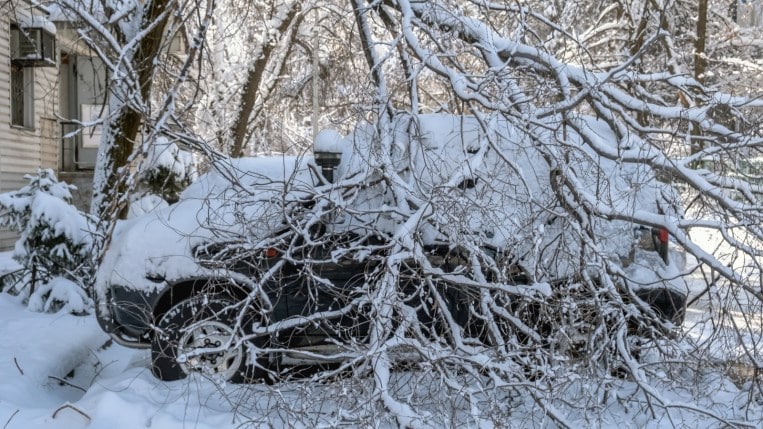
When weather wrecks your car, having the right coverage can make a big difference. Without the right type of car insurance, you could be responsible for weather-related damage.
Which Car Insurance Covers Weather Damage?
Comprehensive coverage can help pay for damage to your vehicle caused by non-crash-related incidents, including the weather. If you have comprehensive coverage, it can help pay for damage due to:
- Floods, hurricanes, and tornados. Rain and high winds can wreak havoc on your vehicle. If your car is damaged or destroyed by a flood, hurricane, or tornado, comprehensive coverage will help pay for repairs or a replacement.
- Falling objects. When storms roll through, tree limbs and other debris can come crashing down on your vehicle. Comprehensive covers falling objects.
- Wildfires. Wildfires are unpredictable and can spread quickly. If a fire damages your vehicle, comprehensive will cover you.
- Earthquakes. Your home isn’t the only thing an earthquake can damage. It can also destroy your car. Comprehensive covers earthquake damage.
- Hail. Hail forms when rain freezes in the upper atmosphere before falling to the ground, where it can cause extensive damage to your vehicle. If your car falls prey to a hailstorm, comprehensive covers it.
- Volcanos. If you live in an area with active volcanos and have comprehensive coverage, the insurer will help pay to repair volcano-related damage.
Is Comprehensive Insurance Required?
Comprehensive coverage is optional in all 50 states. But your lender will likely require it if you have an auto loan or lease. Comprehensive car insurance can help pay for repairs due to weather-related damage. If you don’t have comprehensive coverage, you could be on the hook for repairs or a replacement. Or there may be other ways to get help, but you’ll have to qualify.
If your car gets damaged in a federal emergency zone, you may qualify for a low-interest loan from the Small Business Administration (SBA), which you can use to help repair or replace your vehicle. If the SBA determines that you can’t afford a loan, you may qualify for assistance from the Federal Emergency Management Agency (FEMA) through its “Other Needs Assistance” program. To qualify for FEMA assistance, you must maintain at least the minimum amount of liability coverage your state requires.
What Deductible is Right For Me?
If you need to file a claim under your comprehensive coverage, you’ll have to pay a deductible. A deductible is the portion of the repair costs you have to cover out of pocket. The insurance company pays for costs that exceed your deductible amount up to the vehicle’s actual cash value. To find your vehicle’s pre-accident value, use our valuation tool.
When you purchase coverage, you get to choose the deductible amount. Policies with higher deductibles typically have lower premiums and vice versa. But it’s crucial to select an amount you can afford to pay if you need to file a claim. Don’t select a high deductible to get a reduced rate on your premium if you can’t afford to pay it.
In general, higher deductibles work best for more expensive cars, and lower deductibles are better for less expensive vehicles. But you’ll need to decide what deductible amount is better for you based on what you can afford, the value of your car, and how much it would cost to repair your car.
How to File a Weather-Related Claim
If your vehicle sustains weather-related damage and you need to file a claim, contact your car insurance company as soon as you can.
- Remember the details. Be prepared to provide as many details as possible.
- Photograph the damage. If it’s safe, document the damage with photos, videos, and notes of your observations.
- Prepare to wait. Be patient after you file your claim. If a large-scale event affected many people, it might take longer than usual for the insurance company to resolve your claim.
- Don’t drive the vehicle. Unless you’re 100% sure the damage is minor, don’t drive your car until an adjuster comes to look at it.
- Understand the terms. If your vehicle gets totaled, don’t expect a check for the cost to replace it. The insurance company will only pay out up to the actual cash value of your vehicle (minus your deductible) at the time the incident occurred.
Do You Need Comprehensive Insurance?
If you live in an area where severe weather is typical, it’s a good idea to consider comprehensive insurance. To help you decide whether paying for coverage is worth it, find out what the actual cash value of your vehicle is. If the value of your car is less than the cost of the premium plus your deductible, it probably doesn’t make sense to carry it. But if your vehicle’s worth more than that, having comprehensive could help reduce your out-of-pocket costs if you need to file a claim.
How Much Does Comprehensive Insurance Cost?
According to the Insurance Information Institute, the average cost of comprehensive insurance is about $134 per year. You may pay more or less than the average, based on multiple factors. For example, choosing a higher deductible can help reduce your insurance rate.
Since comprehensive coverage pays out up to the actual cash value of your vehicle, you’ll likely pay more to insure an expensive car than a cheaper one. Insurance companies also consider your driving history when determining rates. If yours is spotty, be prepared to pay more than someone with a clean record.
Related Insurance Stories:
"type" - Google News
October 14, 2021 at 10:00PM
https://ift.tt/3AHnAqG
What Type of Car Insurance Covers Weather-Related Damage? - Kelley Blue Book
"type" - Google News
https://ift.tt/2WhN8Zg
https://ift.tt/2YrjQdq
Bagikan Berita Ini














0 Response to "What Type of Car Insurance Covers Weather-Related Damage? - Kelley Blue Book"
Post a Comment